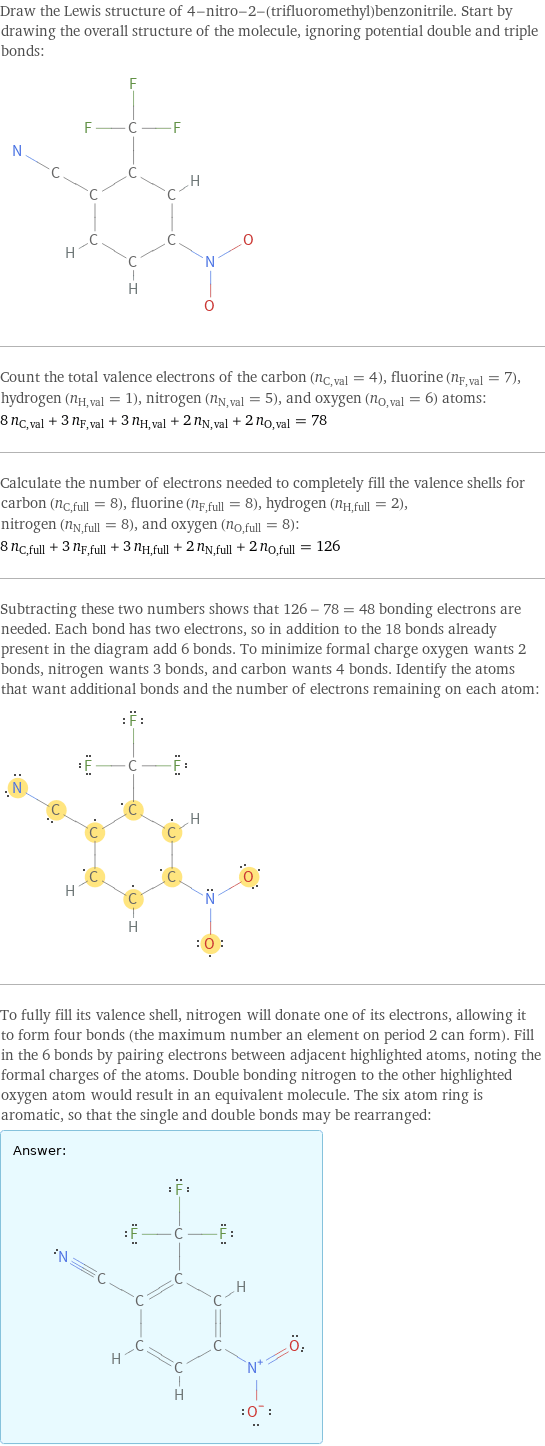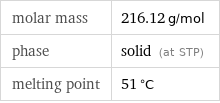Input interpretation

4-nitro-2-(trifluoromethyl)benzonitrile
Chemical names and formulas

formula | O_2NC_6H_3(CF_3)CN Hill formula | C_8H_3F_3N_2O_2 name | 4-nitro-2-(trifluoromethyl)benzonitrile mass fractions | C (carbon) 44.5% | F (fluorine) 26.4% | H (hydrogen) 1.4% | N (nitrogen) 13% | O (oxygen) 14.8%
Lewis structure

Draw the Lewis structure of 4-nitro-2-(trifluoromethyl)benzonitrile. Start by drawing the overall structure of the molecule, ignoring potential double and triple bonds: Count the total valence electrons of the carbon (n_C, val = 4), fluorine (n_F, val = 7), hydrogen (n_H, val = 1), nitrogen (n_N, val = 5), and oxygen (n_O, val = 6) atoms: 8 n_C, val + 3 n_F, val + 3 n_H, val + 2 n_N, val + 2 n_O, val = 78 Calculate the number of electrons needed to completely fill the valence shells for carbon (n_C, full = 8), fluorine (n_F, full = 8), hydrogen (n_H, full = 2), nitrogen (n_N, full = 8), and oxygen (n_O, full = 8): 8 n_C, full + 3 n_F, full + 3 n_H, full + 2 n_N, full + 2 n_O, full = 126 Subtracting these two numbers shows that 126 - 78 = 48 bonding electrons are needed. Each bond has two electrons, so in addition to the 18 bonds already present in the diagram add 6 bonds. To minimize formal charge oxygen wants 2 bonds, nitrogen wants 3 bonds, and carbon wants 4 bonds. Identify the atoms that want additional bonds and the number of electrons remaining on each atom: To fully fill its valence shell, nitrogen will donate one of its electrons, allowing it to form four bonds (the maximum number an element on period 2 can form). Fill in the 6 bonds by pairing electrons between adjacent highlighted atoms, noting the formal charges of the atoms. Double bonding nitrogen to the other highlighted oxygen atom would result in an equivalent molecule. The six atom ring is aromatic, so that the single and double bonds may be rearranged: Answer: | |
3D structure

3D structure
Basic properties

molar mass | 216.12 g/mol phase | solid (at STP) melting point | 51 °C
Units

Chemical identifiers
[O-])C(F)(F)F)C#N InChI identifier | InChI=1/C8H3F3N2O2/c9-8(10, 11)7-3-6(13(14)15)2-1-5(7)4-12/h1-3H MDL number | MFCD01075729](../image_source/4da2c34f371df2a58633d018e0d1e9d7.png)
CAS number | 320-47-8 PubChem CID number | 2775783 PubChem SID number | 24881023 SMILES identifier | C1=CC(=C(C=C1[N+](=O)[O-])C(F)(F)F)C#N InChI identifier | InChI=1/C8H3F3N2O2/c9-8(10, 11)7-3-6(13(14)15)2-1-5(7)4-12/h1-3H MDL number | MFCD01075729
Safety properties

flash point | 110 °C